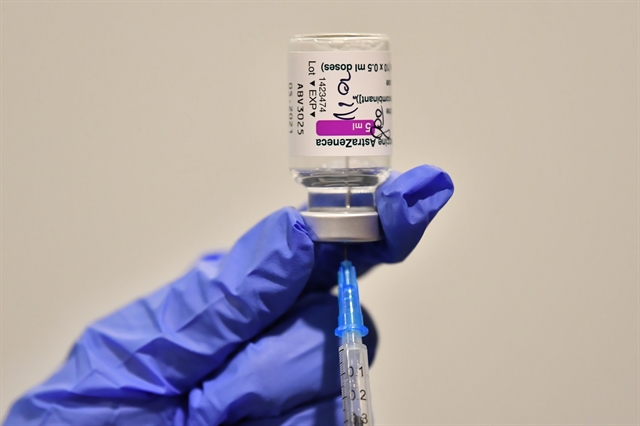 Society
Society

With the first COVID-19 vaccine doses slated to arrive in the country later this month, the Vietnamese health ministry has issued its initial vaccination rollout plan, including the priority groups to be given the jabs.

|
| Oxford/AstraZeneca COVID-19 vaccines are used in the WHO-led Vaccines Global Access (COVAX) initiative, to which Việt Nam is a recipient country. — AFP/VNA Photo |
HÀ NỘI — With the first COVID-19 vaccine doses slated to arrive in the country later this month, the Vietnamese health ministry has issued its initial vaccination rollout plan, including the priority groups to be given the jabs.
The vaccines are from the WHO-led Vaccines Global Access (COVAX) initiative, created mainly to ensure supplies for developing countries. Việt Nam as an eligible recipient is set to receive 30 million doses throughout 2021.
The 11 priority groups are identified based on the outbreak situation and given the current limited supply of vaccines in Việt Nam: medical workers; people in the anti-pandemic efforts (COVID-19 prevention and control steering committees of all levels, quarantine facility staff, reporters, etc.); diplomats, customs officers and people working entry and exit procedures; military personnel; public security forces; teachers; elders above 65 years old; essential workers (aviation, transport, tourism staff, utility workers, etc.); people with chronic health issues; people who want to study or work overseas; and people in virus-hit regions.
The priority ranking is evaluated based on criteria such as areas where COVID-19 cases are present, areas with COVID-19 deaths occurred, major cities with high population density and localities considered traffic and transit hubs.
According to the plan signed off by Deputy Minister of Health Đỗ Xuân Tuyên, the vaccination drive will aim to eventually inoculate 80 per cent of the Vietnamese population against the COVID-19 in a bid to achieve herd immunity.
However, with the current limited supply that they have secured, health authorities are targeting 20 per cent coverage in the 2021-22 period, with 95 per cent of high-risk groups being vaccinated.
The majority of doses from the first batch of 4,886,000 doses from the COVAX mechanism – 25-35 per cent delivered in the first quarter of 2021, and 65-75 per cent delivered in the second quarter – will be given to medical workers.
In the first quarter, the health ministry expects to inoculate 95 per cent of 500,000 frontline medical workers and 116,000 anti-pandemic staff. 1.2 million doses of COVID-19 vaccine are to be used (each will be given two shots as per recommendations).
In the second quarter, the health ministry aims to inoculate 95 per cent of 9,200 customs officers, 4,080 diplomats, 1,027,000 military officers, 304,000 public security officers, and 550,000 teachers that are considered in high risks categories. All in all, 3.6 million doses are to be used in this period for 1.8 million people.
In the third and fourth quarter, if the promise of COVAX Facility to provide enough doses to cover 20 per cent of each eligible recipient country’s population is fulfilled, Việt Nam will inoculate nearly 16.5 million with 33 million doses. 95 per cent of 750,000 teachers, 7,600,000 elders above 65 years old, 1,930,000 essential service workers, and 7,000,000 adults with chronic health issues are to be given the jabs.
Budget
To get protection for the majority of the population, Việt Nam needs to diversify supplies of vaccines – including vaccines manufactured in the country and maximising the resources from the society (businesses and local administration’s budgets) in addition to the State budget to get the vaccination efforts running, deputy health minister Thuần said.
Even localities with sufficient budget which want to purchase the vaccines for their populace will have to follow the central Government’s approved plan, he said.
The budget needed to give vaccine shots for 20 per cent of the population is estimated at VNĐ 6.739 trillion (US$293.67 million), but over 90 per cent of this cost – about VNĐ 6.3 trillion – is shouldered by the COVAX initiative. The State budget will chip in VNĐ24 billion, some municipal and provincial governments have pledged some VNĐ163 billion, the remaining VNĐ202 billion – will need to be mobilised from other sources.
In addition to the 30 million doses committed by COVAX, Việt Nam Vaccine JSC (VNVC) signed a commercial deal with AstraZeneca to buy 30 million doses with its own budget, but the company is not allowed to distribute the vaccines however it wants to and has to follow the health ministry’s plan to ensure that the vaccine drive is implemented in a fair, equitable and effective manner.
Four vaccine manufacturers in Việt Nam are also researching COVID-19 vaccines, with Nano Covax by Nanogen slated to begin phase two of human trial later this month, and another vaccine by VABIOTECH preparing to enter human trials.
Transport and storage
The health ministry said it would only choose to purchase COVID-19 vaccines that are deemed safe and effective, have received prequalification from the World Health Organisation, have obtained approval from a Stringent Regulatory Authority, and have affordable price tags, and preferably, ones that can be stored at the 2-8 degrees Celsius (normal refrigeration temperature which Oxford/AstraZeneca can be kept at, while Pfizer and Moderna vaccines require ultra-cold chain storages).
Vaccines supplied via the COVAX mechanism will enjoy import fee waive, will be imported via Nội Bài International Airport in Hà Nội and Tân Sơn Nhất International Airport in HCM City, automatically given the clearance when they arrived at the airports and then transported directly to State-managed storages to be examined by health authorities.
The transport of vaccines to local areas will be carried out by trained vaccination personnel, the health ministry said.
The health ministry has also surveyed the existing cold chain storage situation in the country and said that at the same time, the available facilities can store 3 million doses at ultra-cold condition (-70 degrees Celsius), 1.8 million doses at -25 degrees Celsius, and tens of millions of doses at standard cold storage temperature 2-8 degrees. — VNS